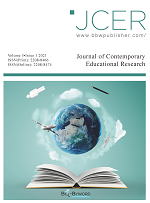Abstract
The precision of mathematical reasoning, the abstractness of mathematical language, the profundity of mathematical thought and method, as well as the excessive formalization of mathematics teaching have formed an impassable gap, hindering students in approaching mathematics. This has concealed the beauty of mathematics and the light of mathematical culture. However, if students are able to cross this gap, they would find that mathematics is a vast world full of vitality, imagination, wisdom, poetry, and beauty. The pursuit of mathematical beauty is one of the motivations for scientists to research this field. Experiencing mathematical beauty is of great significance to students’ learning and growth. In teaching, the value of mathematical beauty is explored, such as stimulating emotions, opening up to the truth, and cultivating goodness. Several effective ways are suggested in this article to guide students to discover the mathematical beauty in life while finding it in problem-solving methods and exploring it in knowledge systems.
References
Chen H, Zhang X, 2008, On the Essential Attribute of Mathematical Beauty. Journal of Mathematics Education, (5): 28-30.
Deng D, 1990, Mathematics and Culture, Peking University press, Beijing, 41.
Several Types of Mathematical Beauty. https://www.docin.com/p-21423184.html (accessed on May 27, 2019).
Middle School Mathematics Room, 2003, Mathematical Culture, People’s Education Press, Beijing, 179.
Ni B, 2010, The Application of Mathematical Beauty in Solving Mathematical Problems in High School. Education Theory and Practice, (8): 50-51.
Zheng Y, 2006, Introduction to Mathematical Methods, Zhejiang Education Press, Hangzhou, 58.
The Golden Ratio. https://www.docin.com/p-8237915.html (accessed on March 19, 2015).
Three Blades Kink. https://baike.baidu.com/item (accessed on November 7, 2011).
Zheng Y, 2006, Introduction to Mathematical Methods, Zhejiang Education Press, Hangzhou, 61.
Gao S, 2019, Dialectical Thinking in the Problem of Chicken and Rabbit Cooped Up – Course Teaching Material. Teaching Method, (9): 88-93.
Zhang L, Tang R, 1996, Mathematics Education, Jiangxi Education Press, Nanchang, 181-182.
Gu M, 1997, The Comprehensive Dictionary of Education, Shanghai Education Press, Shanghai, 562.
Hegel C, 1979, Aesthetics (Volume 1), The Commercial Press, Beijing, 176.
Yi N, 2004, Mathematical Beauty, Science Press, Beijing, 220-221.
Zheng Y, 2005, Mathematical Culturology, Sichuan Education Press, Chengdu, 29-30.
Zhang X, Cheng M, 1994, Beauty theory of Physical Science, Shaanxi People’s Publishing House, Xi’an, 17.
